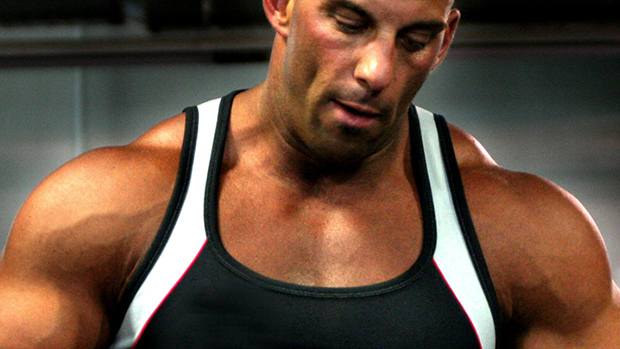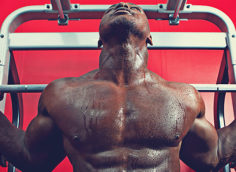What do you get when you ask some of the world's top strength coaches and nutrition gurus to share their most powerful tips for dramatic physique changes? You get one hell of an article series!
In this installment, Christian Thibaudeau lays out his seven most effective tips for getting big, getting strong and performing better. If you want to see some jaw-dropping, holy-cow improvements in your body and performance levels over the next few months, then read on!
Thib's Lucky 7
This might seem odd coming from someone known as a "training guy" and not as a nutrition guru, but it's true nonetheless. If you want to gain maximum muscle size, lose maximum body fat, or gain muscle while losing fat, the real key lies in proper nutritional habits.
It's also my strong belief that the perfect nutrition program doesn't exist. What will work for another person might turn you into a fat slob or an anorexic twig. Nutrition is like training: there's no one-size-fits-all program.
For example, individuals with a lightning fast metabolism (like my intern Nick Roy and many of my players who have a hard time gaining weight) won't progress well on a low (or even moderate) carb diet and/or a moderate-to-high fat diet, especially when it comes to gaining muscle mass. These individuals need a high amount of both protein and carbohydrates to grow.
Furthermore, their caloric intake needs to be very high and they should eat at least six times per day, eight being even better. These guys would simply throw away any muscle mass they might have if they were to follow a diet such as the Atkins/BodyOpus/Anabolic Diet (or other ketogenic diets). Even a balanced diet such as the Zone won't be optimal for them, unless their caloric intake is very high. And let's not even talk about the Warrior Diet (12-18 hours of fasting) unless they want to look like concentration camp victims!
On the opposite side of the spectrum, guys with a slow metabolism (such as myself and my other intern, Alain Watier) will get real fat real soon eating like the above paragraph described. I personally need to keep my carbs low (or moderate at the most) to avoid gaining tons of blubber. I do extremely well on low carb diets, especially of the cyclical nature. I did well on the Velocity Diet as well as on the BodyOpus diet. And I'm now doing even better with the Ultimate Diet 2.0 (which takes cyclical dieting to a brand new level). In fact, even the controversial Warrior Diet worked well for me. Basically, my slow metabolism allows me to go for longer periods without food.

In the pictures above you can see that both Christiane and I were able to get fairly ripped. We both dieted for about the same period of time; I used a lowish carb diet (carb rotation) while she consumed much more carbs than me (not more carbs relative to body weight, more total carbs).
She even ingested slightly more calories per day than me, but we both maintained muscle mass and lost fat. She has a fast metabolism and I have a slow metabolism. Had she used my diet she'd have lost a lot of muscle mass, and had I used hers I'd have gained fat. Diet is important, but dietary individualization is paramount!
Then you have middle-guys who have neither a super fast or super slow metabolism. These guys will do best on a balanced diet containing plenty of all three basic macronutrients. Such diets include John Berardi's Massive Eating and the "Don't Diet" plan as well as the Zone diet by Barry Sears.
When you're trying to lose body fat, strength training should be used as a way to prevent muscle loss or even stimulate muscle gain. It shouldn't be used to stimulate fat loss.
Don't get me wrong, the adaptations to strength training (increased metabolism, added muscle mass, insulin sensitivity, etc.) and increased energy expenditure will contribute somewhat to your fat loss effort. However, you shouldn't design strength training programs aimed solely at burning fat.
Performing high rep exercise with very light weights will do nothing to help preserve (or increase) muscle mass while on a restricted-calorie diet and, in fact, might lead to muscle wasting (catabolism) if the training volume is excessive.
Furthermore, the logic that the growth hormone release from high volume/high density strength training will lead to heaps of fat loss is ludicrous at best. Sure, your body might produce around 0.25 IU more than it normally would, but considering that using 2-4 IU of exogenous hGH for at least two to three months is necessary to see any significant fat loss, how will that slight natural increase do anything to make you look better? The answer is: it won't! (In fact, many bodybuilders insist that anything below 6 IU per day is a waste!)
Did you know that one of the best ways to stimulate natural growth hormone production is to fast (i.e. don't eat)? It's true. The GH release from that situation is much more pronounced than during a training session. But do you honestly believe that starvation will lead to a ripped muscular physique? Of course not!
Then there's the argument that high rep training will increase energy expenditure more so than lower reps/higher intensity training. While technically true, the difference isn't that great. And if you're in a deprived state, a lot of the required calories will come from the conversion of some amino acids to glucose (BCAA, taurine and glutamine notably). So you'll either use the protein you ingest (in hope of building muscle) to produce energy or end up using your muscles to produce the energy. This is kinda like burning the walls to heat the house!
So the bottom line is that most of your fat loss will come from your dietary approach, energy systems work, and metabolism maintenance due to gains of muscle mass.
A strong man is strong in the back of his body. Okay, Westside Barbell followers will notice that I stole that quote from Louie Simmons. But when someone is right, he's right... and Louie is right most of the time!
With most athletes, the fastest way to improve performance is to get stronger and more powerful in the muscles that you don't see: those in the back of ya! Specifically, I'm talking about hamstrings, glutes, calves, erector spinea (lower back), lats, rhomboids, traps and triceps. Except for the triceps, these muscles are underdeveloped most of the time with athletes. Why? Because it's much more fun and rewarding to work the muscles in front of your body! As a result, the athlete ends up doing less work for the backside muscles, or doing enough work but with much less intensity.
In the initial phase of an athletic program, performance can be increased at an alarming rate by doing a "backside specialization" program along with maintenance "frontside" work. I'm talking something along the lines of a 2:1 ratio (twice as much work for the backside muscles as for the frontside muscles). Some athletes will need as much as a 3:1 ratio to see fast improvements.
Periodization of training does have a special aura to it. Maybe because the texts written about it are much more complex then they need to be (most of the time the authors, Ph.D. types normally, do so just to look smart). However, periodization is nothing more than a series of pre-planned changes in training methods and emphasis. Basically it divides training into "periods" or "phases," each phase having a slightly different focus, or using different training methods.
The problem with the "old-school" periodization schemes (besides being overly complex) is that, well, they just don't work very well! They're built on a long training cycle (at least 12 weeks) during which volume is gradually decreased (starts high, ends up low) and intensity is proportionally increased (starts low, end up high). Sounds good on paper, but it's not always well adapted to most sports. (It's okay for sports where you have to peak for a short period of time, once or twice per year.)
Most importantly, it allows for little leeway and adjusting. Furthermore, the early training periods will do little, if anything, to increase muscle mass and power, and the newly acquired muscle mass from the early periods isn't always maintained during the later high intensity phase. So, basically, you can't progress maximally in the long run with this approach.
I still find it important to change training focus and methods to make sure that the athlete improves maximally, but I prefer to do so using short accumulation and intensification phases. These will last three to four weeks each. (Normally I stick to three weeks.)
The accumulation periods are aimed either at increasing muscle mass as much as possible (in the case of a bodybuilder or someone training to improve his looks) or at placing an athlete in an overreaching state (short term, transient, overtraining state) by using a high volume of physical work and a wide array of training techniques.
The intensification periods are also called "realization blocks": at that time the amount of physical work being performed is drastically decreased and the intensity drastically increased. During these periods, great strength and power gains can be made, especially if the proper training methods are used.
For bodybuilders, this phase allows the muscles to fully recover from the high volume of work, which will lead to a surcompensation (increase beyond normal levels) in glycogen stores and protein accretion. In simpler words, during the accumulation phase you place an important growth stimulus on your body, sometimes more than it can handle, and during the subsequent intensification phase, the decreased volume of work allows your body time to "realize" the gains stimulated from the earlier phase. The increase in cell volumization (increased intramuscular glycogen and water storage) and protein accretion will lead to both maximum non-functional and functional hypertrophy.
Lastly, lifting bigger weights has benefits on its own when it comes to stimulating muscle mass, so you can continue to cause new muscle growth during the intensification phases. Athletes will benefit most from the intensification phase by having a "mini-peak." Their accumulation period is a bit different than a bodybuilder's accumulation period (the average intensity is a bit higher). In their cases, during the intensification phases they'll jump to a new level in CNS efficiency, improving their performance level by leaps and bounds!
What do accumulation and intensification periods look like? While there's no "set in stone" training parameters, the following guidelines are a good starting point:
1.1. Accumulation Period for Bodybuilders
- Frequency: Each muscle group is trained 1-2 times per week.
- Volume (sets): The volume should be high, around 9 to 12 sets per muscle group.
- Volume (reps): It should also be high, in the 6 to 12 reps per set range for the most part.
- Intensity (%): It should be moderate, 70-80%. Once past the intermediate level, never go below 60% (unless doing explosive work).
- Training techniques: Straight sets, post-fatigue, medium reps cluster, yielding isometrics for time, iso-dynamic contrast, tempo contrast.
- Rest intervals: 1 to 3 minutes depending on training technique.
1.2. Accumulation Period for Strength/Power Athletes
- Frequency: Each basic movement structure * being trained 2-3 times per week.
- Volume (sets): The volume should be moderate, around 6 to 9 sets per movement structure.
- Volume (reps): Also moderate, in the 6 to 8 reps per set range for the most part.
- Intensity (%): Moderate, 75-85%. Once past the intermediate level, never go below 70% (unless doing explosive work).
- Training techniques: Straight sets, medium rep cluster, overcoming isometrics for time, Olympic lift variations, superslow eccentrics.
- Rest intervals: 2 to 4 minutes depending on training technique.
* Movement structures: upper body push, upper body pull, hips dominant, quad dominant, whole body.
2.1. Intensification Period for Bodybuilders
- Frequency: Each muscle group being trained 2-3 times per week.
- Volume (sets): The volume should be low, around 3 to 6 sets per muscle group.
- Volume (reps): Moderate, in the 4 to 6 reps per set range for the most part.
- Intensity (%): Relatively high, 80-90%. Once past the intermediate level, never go below 70% (unless doing explosive work).
- Training techniques: Straight sets, medium rep cluster, heavy iso-dynamic contrast, low reps post-fatigue.
- Rest intervals: 2 to 4 minutes depending on training technique.
2.2. Intensification Period for Strength/Power Athletes
- Frequency: Each basic movement structure being trained 3-4 times per week.
- Volume (sets): The volume should be low, around 3 to 6 sets per movement structure.
- Volume (reps): Low, in the 1 to 5 reps per set range.
- Intensity (%): It should be near-maximal, 90-100%. Once past the intermediate level, never go below 80% (again, unless doing explosive work).
- Training techniques: Straight sets, pure cluster, overcoming isometrics for intensity, Olympic lift variations, manual eccentric overload (or weight releasers).
- Rest intervals: 2 to 4 minutes depending on training technique.
Accumulation-intensification rotation is tremendously effective. I use this method with all of my athletes and all show truly amazing results in a 12 week period (two full rotations). Furthermore, it'll allow you to use a wide array of training techniques and exercises so your training can be kept fun and effective.
This one is for the athletes and coaches out there. Plyometrics (and I'm talking about real plyo drills like depth jumps, altitude landing and depth push-ups) are probably the most abused of all the training techniques used by strength coaches.
First let me say that, used wisely, it's a very effective training technique: properly applied plyo training can significantly increase jumping capacity, power output and sprinting speed. This is well documented. Depth jumping will improve performance via several factors:
1. An increase in reactive strength.
Reactive strength refers to the capacity to rapidly switch from an eccentric/yielding action to a concentric/overcoming action. Lack of reactive strength will lead to a longer coupling time and, consequently, lower force and power production during the overcoming portion of the movement (Kurz 2001).
2. Neural adaptations.
Viitasalo et al. (1998) found a different neural response between athletes doing a lot of jumping and regular individuals when doing a depth jump. Jumpers were able to activate more motor units during the movement (greater EMG) and initiate the movement faster (higher and more rapid pre-action EMG).
Kyröläinen et al. (1991) also found that 16 weeks of depth jump training led to better jumping efficiency. Schmidtbleicher (1987 and 1982) found that trained subjects were able to use the kinetic energy produced during the eccentric portion of a depth jump, while in untrained subjects this eccentric period was actually inhibiting instead of potentiating!
Finally, Walshe et al. (1998) concluded that the superiority of depth jump training over regular jump training was due to "the attainment of a higher active muscle state," meaning that the fast eccentric portion of the movement increased muscle activation.
3. Structural adaptations.
Depth jumps have been reported to cause some muscle soreness and muscle damage (Horita et al. 1999). This is understandable since the eccentric force produced is very high, albeit rapid. This may indicate that depth jumps are a powerful stimulus to stimulate structural adaptations. However, depth jumps don't lead to significant hypertrophy. So, the nature of the structural adaptations following depth jumping isn't quantitative in nature, but qualitative: an improvement of the strength and contractile capacity of each muscle fiber.
Furthermore, the gains from plyometric training occur very rapidly, so coaches actually make it out to be some sort of magical training technique. Since it's so effective they want to use it all the time. The thing is, after a few weeks of plyometric training, there's no further gains in power (Roman 1986). So if you perform it year 'round it just doesn't give you anything more than using it in three to four week blocks a few times in a year.
The second reason why plyos are overdone is that you don't get tired from them, at least not as much as when you perform squats and deadlifts. Many athletes (and sadly, coaches too) evaluate the efficacy of a workout based on fatigue. Since you don't get any localized muscular "tiredness" after three sets of 8-10 depth jumps, coaches will believe that a much higher volume of work is needed to get a training effect.
This will not only be counterproductive (the athlete will learn bad motor habits because of improper muscle activation due to the residual muscle fatigue) but it can also greatly increase the risk of injuries.
Here are some guidelines about plyo training taken from my second book, Theory and Application of Modern Strength and Power Methods:
- The joint position upon landing should be as close as possible to that of an important sport action (Laputin and Oleshko 1982).
- The amortization phase should be short enough to avoid losing the elastic energy produced, but long enough to allow for the shock stretching to occur (Laputin and Oleshko 1982). Research indicates that the elastic energy from landing is stored for up to two seconds. So, in theory, you have a window of two seconds between the landing and take-off phase. However, to maximize the training effect you shouldn't spend more than one second on the floor.
- The height of the drop should be regulated by the preparedness of the athlete. The heels shouldn't touch the ground during the landing phase. If they do, then the height of the drop is too high (Laputin and Oleshko 1982). A height varying from 0.5m to 0.7m appears to be ideal for most strength and power athletes (Roman 1986).
- Depth jumps have a very powerful training effect, so the volume of work should be low, i.e. no more than four sets of 10 repetitions (or 40 total jumps spread over more sets), two to three times per week for advanced athletes and three sets of 5-8 repetitions (or 15-24 total jumps spread over more sets), one to two times per week for lower classes of athletes (Laputin and Oleshko 1982).
- Because of the very powerful training effect of depth jumping, it's idiotic to perform this type of training systematically throughout the year. The shock method should be used in blocks of three to four weeks with at least four weeks between blocks (Roman 1986). In fact, some coaches recommend no more than two to three such blocks per year (Medvedyev 1996), and only when a rapid rise in power and reactive strength is needed to further performance gains.
Remember that every training method, regardless of how effective it is, will lose its effectiveness over time. Shock training is no different. If you use it year 'round, there comes a point where you'll get no added benefits from it. However, by using short "shock" blocks you can give a quick boost to your performance. Since you only use depth jumps for a short period, you'll get the same performance boost every time you use such a shock block.
So, in short, plyometric training has its uses, but don't abuse it.
Strength training will never be entirely sport-specific. The only thing that's truly sport-specific is playing your sport. That's not to say that there's no carryover to athletic performance from a strength-training program. However, you should see strength-training as "general but specialized training" not as specific training.
The objectives of a strength program should be 1) to increase strength and power in the major muscle groups of the body with an emphasis on the muscles involved in the sport practiced, 2) to improve overall central nervous system efficiency by using high force training methods (heavy lifting, explosive lifting, plyometric training), 3) to increase tendon strength, and 4) to correct muscle imbalances.
Don't try to duplicate a sporting movement in the gym. Don't select an exercise because it "looks like" throwing a football or tackling an opponent. And most of all, please, don't use unstable training techniques with the hope of improving balance on the field of play!
Do try to get as strong as possible in all the major muscle groups. Do select exercises that'll work many muscle groups at the same time. Do train heavy and explosively, and do select a few more exercises for the muscles groups that are holding you back.
I want to bench press a ton, but I also want to have big arms, round shoulders and washboard abs. I want to look good for the ladies so give me some lean legs and a tiny, firm set of glutes.
Hey, I have an idea! I'll use a Westside bench press program, throw in Charles Staley's EDT for arms, Christian's "Abs Training for Babehounds" and his Shoulders Overhaul program, and for legs I'll go with Ian King's Limping Series. That should allow me to reach all of my goals in no time!
Wrong! Boy, is this wrong... This is one of the most idiotic things I see in gyms all around the world. Listen to me, folks: a training program (especially a training system like Westside, EDT and my accumulation/intensification rotation) is designed to work as a whole. Believe it or not, there's a logic behind everything. The individual sessions are designed to allow you to reap the most out of every single workout. You can't go Frankenstein on us and try to create the "ultimate program" by throwing in a little of everything. It just won't work!
You can, however, divide your goals into blocks so you can focus on a single goal at a time, then move on to a new objective once the first one is met. But please, don't try to be and do everything all at once. You'll end up disappointed.
Work these seven tips into your yearly training and you're sure to see faster progress and improved gains!




